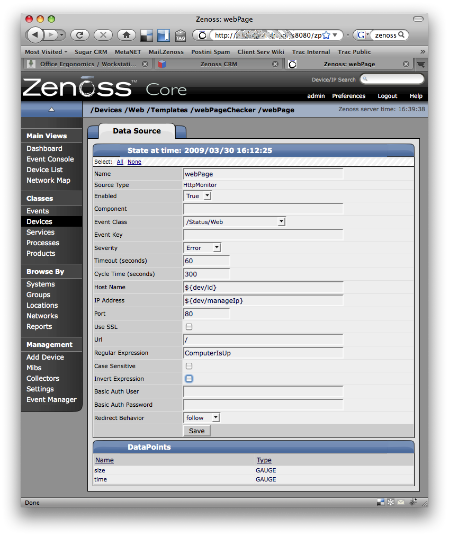The following list items explain the various fields in the httpmonitor datasource
- Name
- Arbitrary title given to data source
- Source Type
- This is not an option. In our case, it is the HttpMonitor Type. This field defines what category of data is being worked on. You may see others like “SNMP”, or “DNSMonitor”
- Enabled
- You can use this to turn on/off this data source. This may be useful if you want to turn off the functionality of the data source, but don’t want to delete it. This makes for an easy process to turn the data source back on, in the future.
- Component
- Events that happen will get this component (like eth0, httpd, etc)
- Event Class
- Which Event Class any events will belong to, if they happen. Different from Device Classes
- Event Key
- If a component needs further deduplication specification this field may be used. Deduplication is when an event is determined if it is the same as another event, and therefore classified as the same or separate event.
- Severity
- Original severity of events that this source cause
- Timeout (seconds)
- Amount of time that can go by, before the transaction is labeled as not happening (timed out)
- Cycle Time (seconds)
- Time between re-runs of HttpMonitor, defaults to 300 seconds
- Host Name
- This is the domain of the website that you want to check. Enter a Fully Qualified Domain Name (FQDN), ex: host.zenoss.com; This field defaults to ${dev/id}, which references the current devices ID. If you reference the current devices ID, and it is not a domain name, HttpMonitor will not work properly.
- IP Address
- IP to use if needed, eg: 124.12.56.123; defaults to use zope object ${dev/manageIp}, which references the current devices IP address
- Port
- If you have web server running on non-standard port (ex: Zenoss runs 8080 by default)
- Use SSL
- HTTPS for secure, encrypted webpages
- Url
- Usually the directory and file names after the host name
- Ex: You have already defined http://host.zenoss.com above
- inserting a / is just the root
- inserting /vm1/insert.php will interpret as http://host.zenoss.com/vm1/insert.php
- Regular Expression
- Uses PCRE regular expression syntax to find the regex on the page loaded
- If not found, throws error of level ‘Severity’ set above
- Case Sensitive
- Does regex care about upper and lower case when searching for string?
- Invert Expression
- Negates Regex logic.
- I regex found, throws error
- Basic Auth User
- If webpage requires basic login authentication
- Basic Auth Password
- See above
- Redirect Behavior
- If page visited trys to redirect, what is done?





